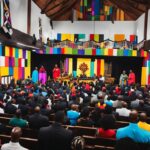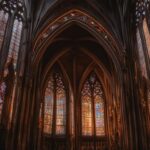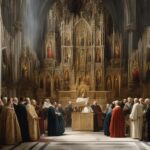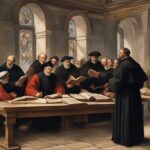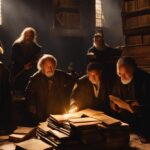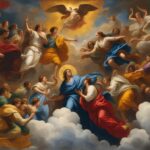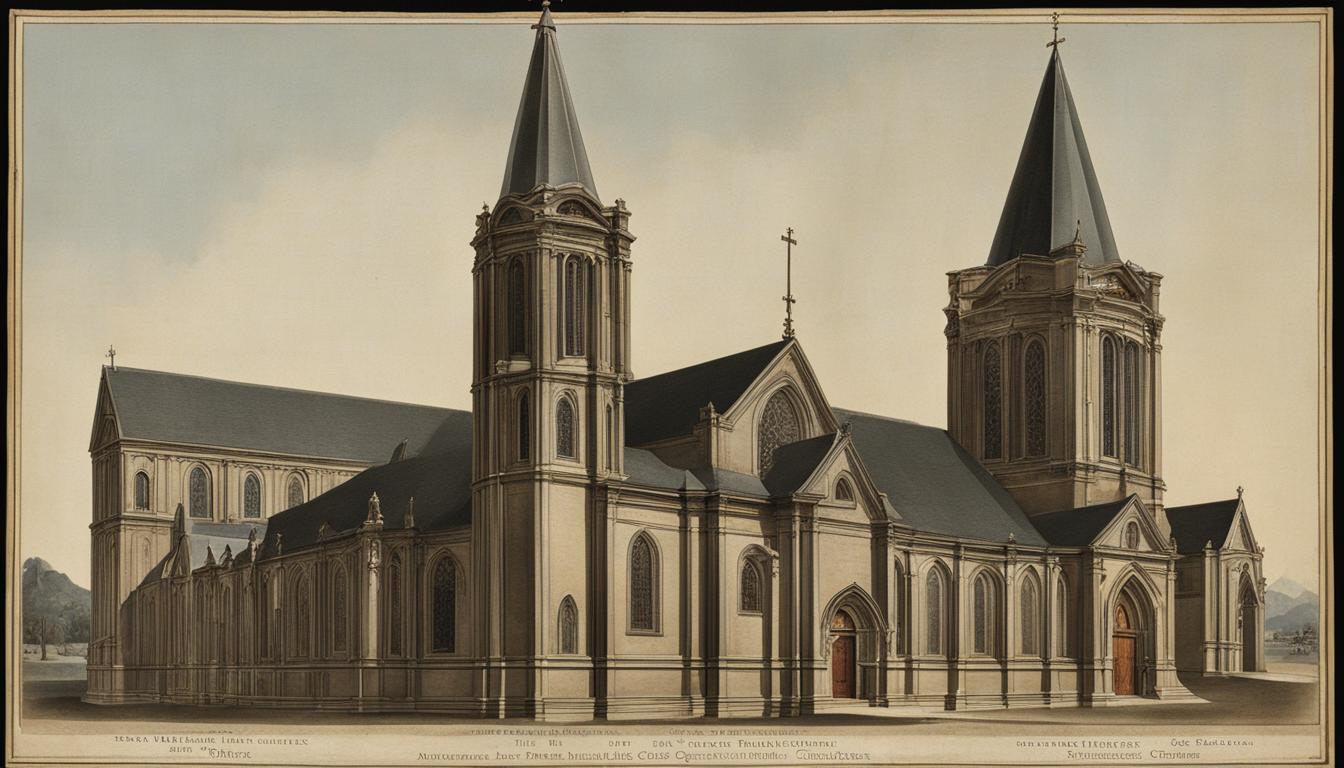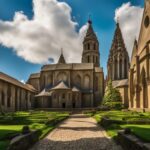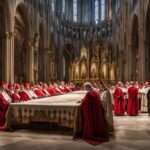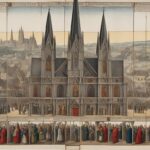Step back in time and explore the captivating history of the medieval church. This influential institution, with its majestic cathedrals and awe-inspiring architecture, played a central role in the lives of people during this extraordinary period.
The medieval church faced challenges and underwent transformative moments, such as the Protestant Reformation. Yet, it also provided vital social services, caring for the sick, the poor, and orphans in the community.
During the Black Death pandemic, the authority of the church was questioned. However, it remained an influential and steadfast institution, leaving an indelible mark on medieval society.
Key Takeaways:
- The medieval church was the dominant religious institution in Europe, and it left an enduring legacy.
- Medieval cathedrals and their breathtaking architecture symbolized the grandeur and power of the church.
- The church faced challenges, such as the Protestant Reformation, but also provided essential social services.
- During the Black Death, the church’s authority was questioned, yet it remained a pillar of medieval society.
- The influence of the medieval church can still be seen today in its architectural marvels and societal impact.
Origins and Beliefs of the Medieval Church
The medieval Church derived its authority from a divine source, claiming a direct link to God through Jesus Christ. At the head of the Church stood the Pope, who was believed to be the successor of Saint Peter, the first Bishop of Rome.
The core beliefs of the medieval Church revolved around Jesus as the son of God and the scriptures as the word of God. The Bible, consisting of the Old and New Testaments, served as the guiding text for Christian doctrine.
Medieval theologians emphasized the importance of faith, salvation, and the sacraments. They taught that salvation could only be obtained through faith in Jesus Christ and the acceptance of his sacrifice on the cross. The sacraments, including baptism, confirmation, Eucharist (or communion), confession, marriage, ordination, and last rites, were seen as essential rituals that conveyed God’s grace and facilitated spiritual growth.
The Church hierarchy played a vital role in preserving and interpreting the scriptures, ensuring the proper guidance of the faithful. The Pope, as the highest authority, possessed the power to make doctrinal decisions, excommunicate individuals, and declare saints. Cardinals, bishops, and priests assisted in carrying out the Church’s religious and administrative duties.
The medieval Church also taught a hierarchical view of society, which reflected the belief that God ordained each person’s place in the world. Social mobility was considered limited, and individuals were encouraged to accept their circumstances as part of God’s divine plan.
The Church’s teachings and beliefs shaped the social, political, and cultural landscape of medieval Europe, inspiring individuals and communities to lead lives aligned with Christian values.
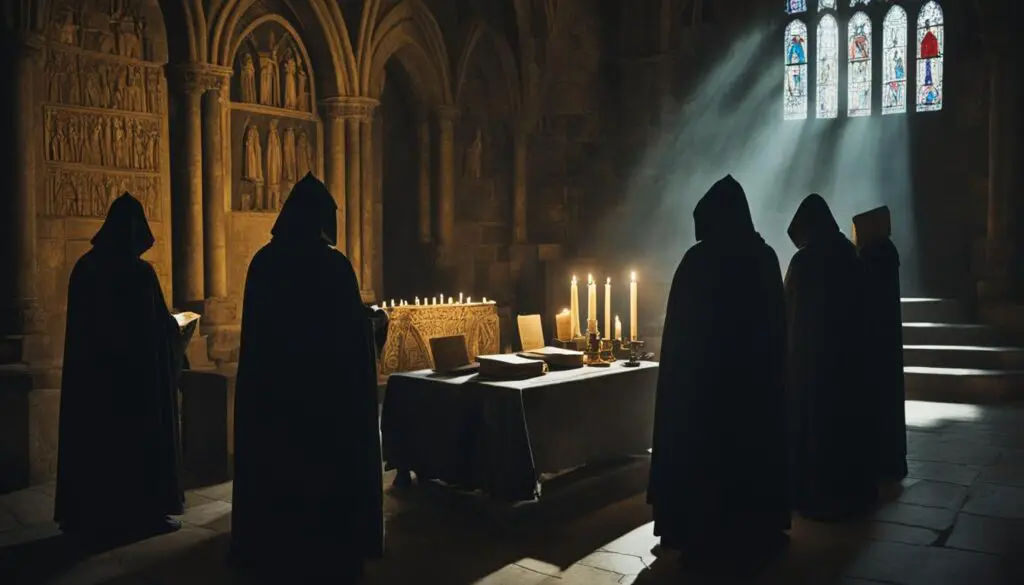
Sacraments and Rituals in the Medieval Church
In the medieval Church, sacraments and rituals formed a crucial part of religious practice and spiritual devotion. These sacred practices were deeply rooted in the beliefs and doctrines of the Church, offering individuals a path to salvation and a closer connection with God.
One of the central sacraments in the medieval Church was baptism. It marked the initiation into the Christian faith and the cleansing of original sin. Through the sacrament of confirmation, individuals received the fullness of the Holy Spirit, strengthening their faith and commitment to God.
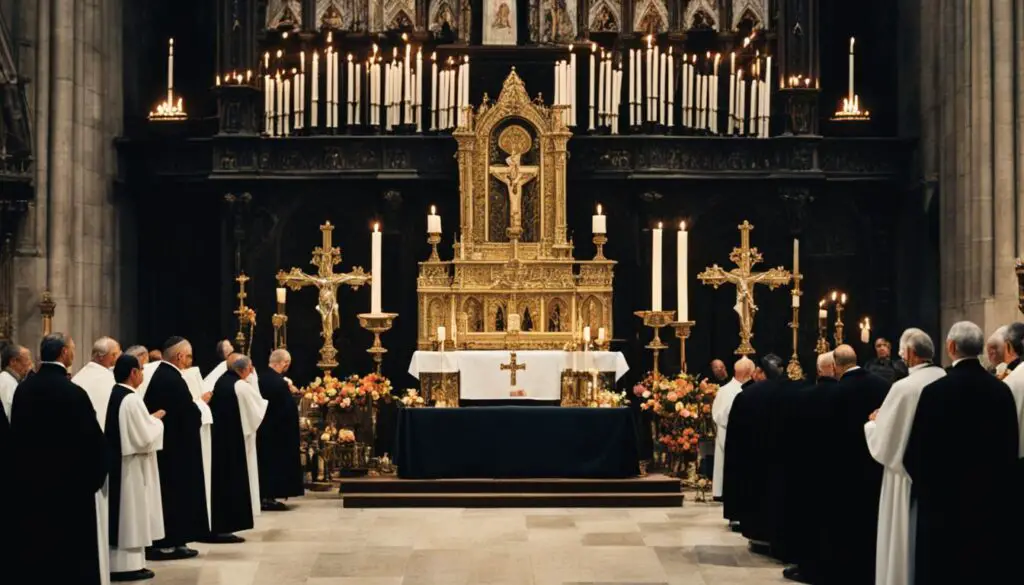
The medieval Church believed that these sacraments provided grace and forgiveness of sins, serving as important milestones in a person’s spiritual journey.
The Eucharist, also known as the Holy Communion, was a central ritual in the medieval Church. During this ceremony, the bread and wine were believed to transform into the actual body and blood of Christ. Participating in the Eucharist was seen as a way to remember and connect with the sacrificial love of Jesus.
Confession, another significant sacrament, allowed individuals to seek forgiveness for their sins. The clergy acted as mediators between the faithful and God, administering absolution and guiding penitents on their path to reconciliation.
List of Sacraments and Rituals in the Medieval Church:
| Sacrament/Ritual | Description |
|---|---|
| Baptism | Initiation into the Christian faith and cleansing of original sin |
| Confirmation | Receiving the fullness of the Holy Spirit and strengthening of faith |
| Funeral Rites | Commending the deceased to God’s mercy and praying for their soul |
| The Eucharist (Holy Communion) | Partaking in the body and blood of Christ to remember His sacrifice |
| Confession | Seeking forgiveness for sins and receiving absolution |
These sacraments and rituals were administered by the clergy, who played a vital role in the spiritual life of medieval communities. They provided guidance, facilitated religious ceremonies, and acted as intermediaries between individuals and God. The rituals and sacraments of the medieval Church not only served as transformative experiences for the faithful but also reinforced the authority and influence of the Church itself.
Leadership and Clergy of the Medieval Church
The medieval Church had a well-defined hierarchical structure that governed its operations and ensured the smooth functioning of its religious and administrative activities. At the top of the hierarchy stood the Pope, who possessed ultimate authority over all matters pertaining to the Church. Below the Pope, several positions of leadership and responsibility were held by individuals such as cardinals, bishops, priests, and monastic orders.
The clergy, comprising individuals ordained into religious service, played a central role in the medieval Church. They were responsible for guiding and serving the faithful, interpreting scriptures, and conducting sacraments and rituals. The clergy’s dedication and commitment to their vocation were instrumental in providing spiritual guidance and support to the community.
However, the medieval Church was not immune to instances of corruption and abuse within its clergy. While the majority of clergy members faithfully adhered to their calling, there were some who exploited their positions of power for personal gain or engaged in morally reprehensible behavior. These instances tarnished the reputation of the Church and created an atmosphere of skepticism and doubt among the faithful.
The Church leadership recognizes the importance of addressing these issues and maintaining the integrity of the clergy. Efforts are being made to foster transparency, accountability, and ethical conduct among the clergy, ensuring that they uphold the values and teachings of the Church.
“The leadership and clergy of the medieval Church played a vital role in guiding the faithful, administering sacraments, and fostering spiritual growth. Although challenges and abuses existed, their commitment to the Church’s mission remains a testament to the enduring influence of the medieval Church.”
Key Positions in the Medieval Church Hierarchy:
| Position | Responsibilities |
|---|---|
| Pope | Overall authority over the Church, issuing decrees and guiding doctrine |
| Cardinals | Assist the Pope in governing the Church, electing a new Pope when necessary |
| Bishops | Oversee the administration of dioceses and ensure the spiritual well-being of the faithful |
| Priests | Lead congregations, administer sacraments, and provide pastoral care |
| Monastic Orders | Live a religious life dedicated to prayer, study, and community service |
The hierarchy of the medieval Church facilitated the management and organization of religious affairs, ensuring the widespread dissemination of religious teachings and the provision of spiritual guidance to the faithful.
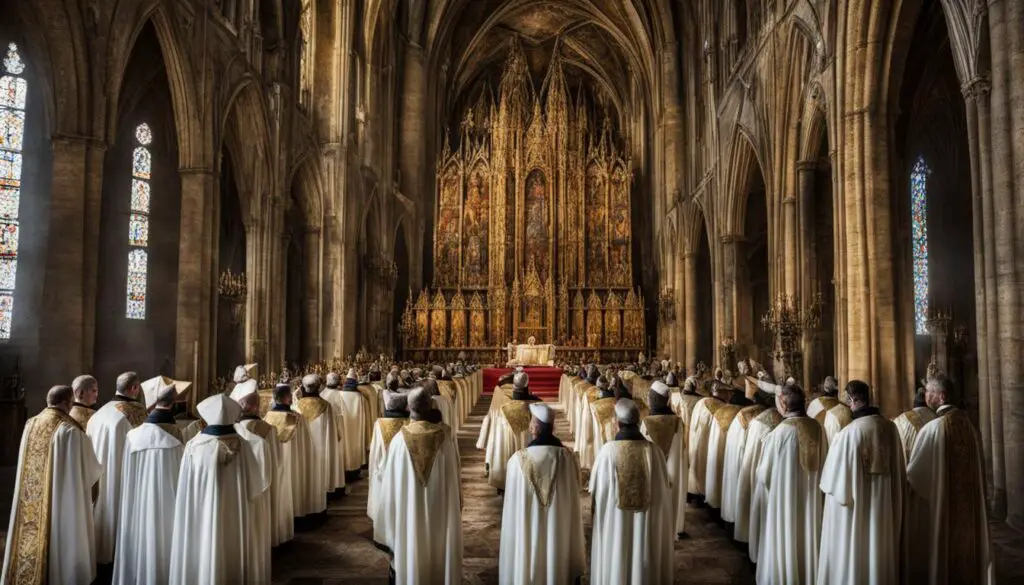
The image above depicts an illuminated manuscript showcasing the medieval Church hierarchy, emphasizing the significant role played by the clergy in their leadership positions within the Church.
Worship Practices in the Medieval Church
Worship in the medieval Church held immense significance in the lives of individuals. It was a daily commitment that involved attending church multiple times for prayers and services. This devout participation allowed individuals to connect with their faith, seek spiritual guidance, and deepen their relationship with God.

The worship experience in the medieval Church encompassed various elements, each contributing to a profound spiritual encounter. Singing hymns and chants uplifted the souls of worshippers, stirring devotion and adoration. The power of music transported individuals to a higher realm, offering solace and inspiration in their spiritual journey.
Prayers held a central position in medieval church services, acting as a way for individuals to communicate with God. Congregants would join together in communal prayers, expressing their hopes, supplications, and gratitude. These prayers provided comfort, guidance, and a sense of unity within the church community.
“Prayers are the keys to the heavenly gates, unlocking the blessings of God’s grace.”
Participation in the sacraments was a vital aspect of worship in the medieval Church. These sacred rituals, such as baptism, confirmation, and the Holy Eucharist, were believed to bestow spiritual grace and salvation upon the faithful. The sacraments represented key milestones in an individual’s spiritual journey, marking their commitment and dedication to their faith.
To sustain its activities and provide for the community, the medieval Church relied on the support of its members through tithes and offerings. The act of giving back was considered a form of worship in itself, reinforcing the spirit of generosity and devotion. These contributions sustained the Church’s ability to carry out its religious services, care for the needy, and preserve its spiritual heritage.
Worship practices in the medieval Church served as a cornerstone of the faith and played a vital role in the lives of individuals. They provided a space for believers to come together, express their devotion, seek solace, and experience a profound connection with the divine. These practices upheld the spiritual well-being of the faithful and nurtured their faith in the medieval era.
Sacred Texts of the Medieval Church
The medieval Church considered the Bible as the word of God and the oldest book in the world. It was revered as the ultimate authority on religious teachings and beliefs. The scriptures, encompassing the Christian Old Testament, were believed to prophesy the coming of Jesus Christ, the central figure of Christianity.
Interpretation of the Bible was primarily entrusted to the clergy, who believed they possessed a divine authority to understand and teach it accurately. The complex nature of the text required deep knowledge and extensive theological training. The clergy’s role as interpreters ensured that the teachings of the Church were rooted in the sacred texts and aligned with the doctrines.
The Bible served as a guide for moral principles, ethical conduct, and spiritual guidance. It provided a framework for understanding the nature of God, the origins of humanity, and the paths to salvation. The sacred texts of the medieval Church played a vital role in shaping the beliefs and practices of the faithful.
“The whole of Sacred Scripture is summed up in the two commands of love—the two great lights of the Bible: love of God and love of neighbor.”
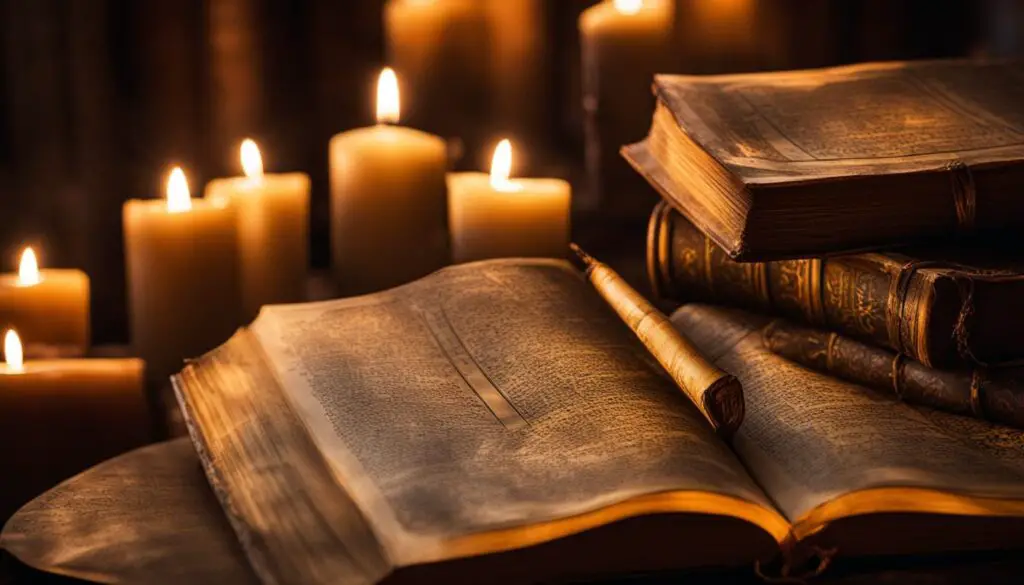
Significance of Biblical Manuscripts
Biblical manuscripts were meticulously hand-copied by scribes and monks in monastic scriptoria, the designated areas for the transcription of religious texts. These manuscripts were works of art, featuring exquisite calligraphy, intricate illuminations, and vibrant illustrations.
The meticulous process of copying and illuminating the Bible ensured its preservation and dissemination throughout the medieval period. Manuscripts were treasured possessions of the Church and noble families, often housed in ornate bindings and secured in library collections.
| Types of Biblical Manuscripts | Characteristics |
|---|---|
| Gospel Books | Contained the four Gospels of Matthew, Mark, Luke, and John, often accompanied by decorative illustrations of the evangelists and scenes from Jesus’ life. |
| Bibles | Included the entire Christian Old Testament and New Testament, providing a comprehensive collection of sacred texts. |
| Psalters | Focused on the Book of Psalms, encompassing prayers, hymns, and poetic verses. |
These handwritten manuscripts were not only religious texts but symbols of devotion and reverence. They were meticulously crafted to enrich the spiritual experience of the faithful, showcasing the beauty and sacredness of the written word of God.
Denominations and Sects in the Medieval Church
During the medieval period, the Catholic Church stood as the prominent form of Christianity. However, alongside the Catholic Church, there were various religious sects and movements that challenged its authority and practices. Two notable examples include the Bogomils and the Cathars.
“The true Church was not to be found in the outward, visible structure, but rather in the purity of the individual’s faith and spiritual experiences.”
– Bogomils
The Bogomils emerged in the 10th century and promoted a dualistic theology that rejected the material world. They believed that the spiritual realm was superior and that the physical world was created by an evil demiurge. The Bogomils rejected the sacraments and rituals of the Catholic Church, emphasizing individual spiritual experiences and ascetic practices instead.
“We reject the baptism of infants, as they are unable to confess their faith and be true followers of Christ.”
– Cathars
The Cathars, also known as the Albigensians, emerged in the 12th century and challenged the Catholic Church’s teachings and practices. They believed in a strict dualism, dividing the world into two opposing forces – good and evil. The Cathars rejected the authority of the Pope and denounced the sacraments of the Catholic Church, particularly baptism.
Both the Bogomils and the Cathars criticized the corruption and abuses within the Catholic Church, advocating for a simpler and more spiritual form of Christianity. Their dissent and challenges to the established religious order laid the groundwork for later reformers, such as Martin Luther during the Protestant Reformation.
| Sect | Beliefs | Practices |
|---|---|---|
| Bogomils | Dualistic theology, rejection of material world | Individual spiritual experiences, ascetic practices |
| Cathars | Strict dualism, rejection of Catholic Church authority | Denouncement of sacraments, rejection of baptism |
Community and Outreach in the Medieval Church
The medieval Church was not only a religious institution but also an integral part of the community, providing support and services to the population. It established institutions and programs to care for the sick, assist the poor, and aid widows and orphans. Over time, the Church’s influence expanded to include education and vocational opportunities for women, further strengthening its connection to the community.
One of the significant ways the medieval Church reached out to others was through missionary activities. Inspired by the teachings of Christ, the Church aimed to spread Christianity to pagan Europe and the Islamic world. Missionaries traveled far and wide, sharing their faith and introducing new communities to the teachings of Christianity. These efforts played a crucial role in shaping the religious landscape of medieval Europe and beyond.
Architectural and Artistic Features of the Medieval Church
The medieval Church was renowned for its impressive architectural and artistic elements, which showcased the spirituality and devotion of the period. One of the most iconic representations of the Church’s architectural grandeur was the Gothic cathedrals. These magnificent structures featured soaring spires that reached towards the heavens, symbolizing the aspiration for spiritual transcendence.
The stained glass windows of the medieval churches were exquisite works of art. Crafted with vibrant colors and intricate designs, these windows depicted biblical scenes and saints, allowing the play of light to create a mesmerizing effect within the sacred space. The stained glass windows served both a spiritual and educational purpose, as they conveyed religious stories to the illiterate masses.
The artistic expressions of the medieval Church extended beyond architecture. Elaborate paintings adorned the walls, depicting biblical events and saints. These works of art invited worshippers to reflect on their faith and provided visual aids for the teachings of the Church. Sculptures, crafted with meticulous detail, brought the figures of saints and religious icons to life, further enhancing the atmosphere of devotion within the church.
Medieval illuminated manuscripts, featuring intricately decorated pages with gold leaf and vibrant pigments, were treasured possessions of the Church. These manuscripts contained sacred texts and beautifully illustrated images that illuminated the spiritual significance of the words they accompanied.
The fusion of architecture, painting, sculpture, and illuminated manuscripts created a rich visual tapestry that enveloped the worshipper in a transcendent experience. The artistic features of the medieval Church not only served a religious purpose but also represented the cultural and artistic achievements of the time.
Examples of Architectural and Artistic Features in Medieval Churches
| Architectural Features | Artistic Features |
|---|---|
| Gothic Cathedrals | Stained Glass Windows |
| Buttresses | Paintings and Murals |
| Rose Windows | Sculptures and Reliefs |
| Pinnacles and Spires | Illuminated Manuscripts |
Contemporary Issues and Challenges for the Medieval Church
The medieval Church, although influential and dominant, was not without its fair share of challenges and controversies. These obstacles tested the authority and integrity of the Church and presented significant hurdles for its leaders and followers.
Protestant Reformation: A Schism in the Church
The Protestant Reformation, spearheaded by Martin Luther in the 16th century, challenged the corruption and abuses within the medieval Church. Luther’s Ninety-Five Theses, in which he criticized the sale of indulgences, caused a schism that led to the establishment of Protestant denominations. This movement questioned the traditional doctrines and practices of the Catholic Church, challenging its authority and leading to a fundamental divide within Christianity.
Authority, Power, and Interpretation
One of the ongoing issues faced by the medieval Church was the debate surrounding authority and power. The Church claimed divine authority, with the Pope serving as the ultimate leader. However, this authority was questioned by various individuals and groups who sought to challenge the Church’s control and interpretation of scriptures. The struggle for power and the competing claims to divine guidance caused rifts and divisions within the Church.
Wealth and Practices Under Scrutiny
The wealth of the medieval Church and its practices came under scrutiny during this period. Critics argued that the Church’s accumulation of vast riches was inconsistent with the teachings of Jesus Christ, who emphasized simplicity and humility. The lavishness of the Church’s architecture, art, and ceremonies raised questions about its commitment to serving the poor and marginalized. These criticisms challenged the Church’s role in society and called for reform and reevaluation of its practices.
“The medieval Church faced numerous challenges, from the Protestant Reformation to questions about authority, power, and wealth. These controversies tested the Church’s resolve and prompted discussions about necessary reforms.”
Conclusion
The medieval Church was a powerful and influential institution that left an indelible mark on society. It shaped belief systems, provided social services, and influenced cultural and artistic expressions. Despite facing challenges and controversies, the Church played a vital role in the lives of people throughout the medieval period.
One of the defining aspects of the medieval Church was its awe-inspiring architecture. Gothic cathedrals, with their soaring spires and intricate stained glass windows, stand as testaments to the faith and creativity of the time. These structures continue to inspire awe and admiration, drawing visitors from around the world. The artistic beauty and attention to detail displayed in the medieval Church’s architecture are unparalleled.
The Church’s rituals and sacraments were integral parts of people’s spiritual journeys. Baptism, confirmation, and funeral rites were seen as pivotal milestones, bestowing grace and forgiveness of sins upon the faithful. The clergy played a central role in administering these sacraments and guiding the religious practices of the community.
However, the medieval Church was not without its controversies. The growth of denominations and sects challenged the Church’s authority and practices. Criticism of corruption and abuses within the clergy also questioned its role in society. The Protestant Reformation, led by figures like Martin Luther, would ultimately lead to a schism, resulting in the establishment of Protestant denominations.
Despite its flaws and challenges, the medieval Church’s legacy cannot be denied. Its impact on history, art, and culture is profound. The Church’s influence extended beyond religious matters, as it established institutions to care for the sick, poor, widows, and orphans. Through missionary activities, the medieval Church spread Christianity to pagan Europe and the Islamic world.
In conclusion, the medieval Church was a complex institution that shaped the lives of people during a significant period in history. Its architectural grandeur, artistic expressions, and cultural contributions continue to inspire and captivate the imagination. The medieval church summary is one of profound spirituality, cultural influence, and social service.
FAQ
What was the role of the medieval Church in Europe?
The medieval Church in Europe played a central role in people’s lives, providing social services and spiritual guidance. It also faced challenges, such as the Protestant Reformation.
Who held authority in the medieval Church?
The Pope was the head of the Church, and authority was claimed from God through Jesus Christ. The Church hierarchy, including cardinals, bishops, priests, and monastic orders, ensured the proper interpretation of scriptures and guidance of the faithful.
What were the sacraments and rituals in the medieval Church?
The medieval Church practiced sacraments such as baptism, confirmation, and funeral rites, which were seen as important milestones in a person’s spiritual journey. Rituals like the Eucharist and confession were also significant.
What was the structure of the medieval Church?
The medieval Church had a hierarchical structure with the Pope as the ultimate authority. Cardinals, bishops, priests, and monastic orders held leadership positions. However, there were instances of corruption and abuse within the clergy.
How did worship occur in the medieval Church?
Worship in the medieval Church involved attending multiple times a day for prayer and services. It included singing, prayers, and participation in sacraments. The Church relied on community support through tithes and offerings.
What was the significance of the Bible in the medieval Church?
The medieval Church considered the Bible as the word of God. Interpretation of the Bible was primarily left to the clergy due to its complexity and belief in their divine authority to understand and teach it accurately.
Were there other religious movements in medieval times?
Yes, there were other religious sects and movements that challenged the authority and practices of the medieval Church. The Bogomils and Cathars were examples of such sects that criticized corruption and abuses.
What was the role of the medieval Church in the community?
The medieval Church provided support and services to the community, including caring for the sick, poor, widows, and orphans. It also contributed to education, vocational opportunities, and engaged in missionary activities.
What were the artistic features of the medieval Church?
The medieval Church was known for its magnificent architecture, such as Gothic cathedrals with soaring spires and stained glass windows. It also produced elaborate artworks, including paintings, sculptures, and illuminated manuscripts.
What challenges did the medieval Church face?
The medieval Church faced challenges such as the Protestant Reformation and controversies surrounding authority, power, and interpretation of scriptures. Criticism of its wealth and practices also questioned its role in society.
What was the overall significance of the medieval Church?
The medieval Church played a crucial role in the lives of people, shaping beliefs, providing social services, and influencing cultural and artistic expressions. Its historical impact is still visible today.

